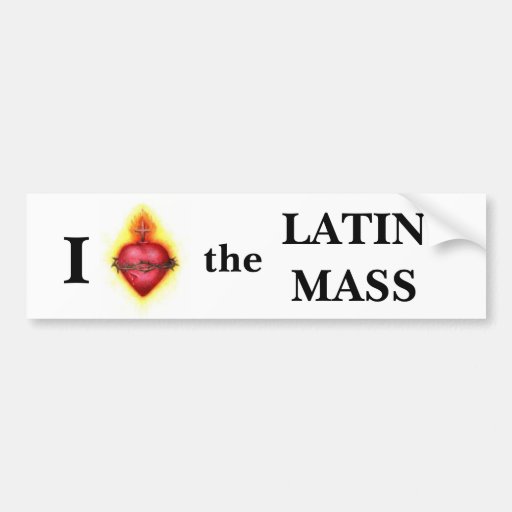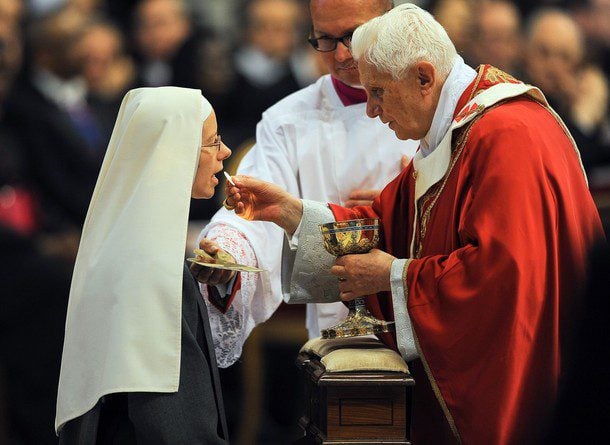Americana Christianity is all a-flutter about losing numbers — or something — a crisis to which pastors are responding by “making Christianity hip.” This, at least, is the conclusion of the New York Times article Los Angeles Churches Make Worship…Hip? which, you guessed it, prescribes Hipness as the cure for Dwindling Congregation Syndrome — a process which seems to involve having Justin Bieber play at your mega-church.
All of which is bemusing to the Catholic, who knows that the best way to make something momentarily-and-then-not-at-all hip is to call it hip, and that the true pinnacle of hipsterdom, nay, the veritable holy grail of obscurity, nay, more than this, the proverbial dollop of incense-flavored side-burn wax scraped from the face of a second-chair cello-player in a post-rock band — is the Latin Mass.
The Times admires how these new megachurches have “a brand cultivated for social media” in which “church events are advertised on Instagram.” But any lummox with free fonts can make a brand cultivated for social media. Look:

Now the Latin Mass, or the Extraordinary Form, or the Tridentine Rite not only has a multitude of not-at-all-intuitive names designed throw off anyone who tries to pin it into a box — it’s devotees have also adopted a post-tumblr, post-aesthetic graphic as their preferred method of promotion:

It’s beyond irony. It’s beyond good and evil. It’s the traditional form of the Catholic Mass in the West, and its fans physically and emotionally wreck the media production of Hillsong-esque churches in the battle for hipsterdom.
You see, Hillsong overshoots: Your average well-produced video of a Worship Night garners somewhere within 100,000 views on the YouTubez, a sure indication that any schmuck with a penchant for smooth shots of light-shows and raised hands can boogie with it. Your typical Latin Mass Promo Video, on the other hand, hits the ideal view-status of 500-20,000 views, putting it in that tasteful neighborhood of Deerhoof playing live in France and “Special Issues in Cider-brewing” Vlogs. View-count Victory, my friends. It’s not about quantity, it’s about quality.
To prove my point, I recently interviewed a young, 20-something standing outside of a Latin Mass.
“Hey,” I said, “do you mind if ask you a few questions?”
“Sure, let me just finish breastfeeding this badass offspring I co-created.” The Church was full of young families busy proving that they could responsibly out-procreate you on any given day of the week, just to make you feel lonely.
“What’s so great about the Latin Mass? Honestly, the way it enlightens several thousand obscure literary references is pretty on point. You haven’t read Hemingway’s A Moveable Feast until you’ve actually participated in a moveable feast.”
“Tell me more,” I said.
“Well, there’s Ulysses, obviously, James Joyce big I-love-the-Mass-sure-sucks-that-I-have-doctrinal issues. I mean, ‘He held the bowl aloft and intoned: Introibo ad altare Dei?’ C’mon. And don’t even get me started on Fitzgerald.”
“F. Scott? He’s-”
“-just a big, drunk aesthetic Catholic wishing he could go up to the altar-rail with the rest of us.”
Hip Churches are lauded for their clever use of technology, in which “congregants send prayer requests via text messages.” The Latin Mass community prefers the Missal, citing post-convenience, a mode of being which involves organizing 11 multi-colored ribbons to hold 11 places within a 110 year-old book — before even walking into church. (All of these pages, it should be mentioned, must be accessed with carefree ease in conjunction with activities at the altar and without snickering at the scrubs who use the handouts.) And though the new megachurches expect mobs of new attendees to follow their openness to alternative expressions of sexuality, the Latin Mass beat them to the punch, and has been featuring a celibate men wearing lace for thousands of years.
The Times article recalls how, “talking about Christian hymns during a service last month at Oasis, the pastor Philip Wagner joked that Journey’s “Don’t Stop Believing” was one of them.” The Latin Mass community, for its part, is a largely post-hymn community, preferring chant, polyphony, or just straight-up silence to Journey. I asked a 8-year old girl in a mantilla — the official merch of the community — whether she got bored when there was no music.
“No,” she said. “The song of the angelic host is sufficient. What, do you get bored? Is it because the silence reveals you to yourself and deems you abhorrent? Here, have a holy card.”

Disturbed, I turned to leave. I found two young men arguing about the distribution of the Eucharist 40 minutes after the priest had gone home. I read them the following quote from the article, hoping to gauge their reaction: “I love that I can understand what they’re saying, and I don’t need somebody to interpret that for me…It just feels really real, really authentic. I think that’s what people want: authenticity and simplicity.”
“What? That’s not what I want.”
“God, no.”
“I’d rather die. Simplicity? I mean, maybe if it’s some kind of radiant core of absolute simplicity that explodes into a Hopkins-esque hierarchical cosmos of complexity, to the point that even the most minute gesture of the Priest becomes radically meaningful in relation to Christ’s singular act of Sacrifice that is the Holy Mass-”
“Did they say they love that you can understand what people are saying?”
“I don’t think he knows about post-comprehensibility, J-Dawg.”
“Do you not know about-”
I didn’t, so I tried another quote: “Relevance to culture is not optional. Culture is always changing, and if we’re not creating a space that has anything relatable, it wouldn’t be enjoyable.” I tried to catch their response, but the two men were walking away fast, and all I heard was something about “taking a spork, scooping it under my eyelid, and just pushing.”
My success as an interviewer seemed iffy. What remains clear is that the Extraordinary Form of the Mass and its growing counter-cultural popularity presents an alternative route to the hipifying impulse of the modern Christian. ‘Relevance,’ the illusive goal of any pastor worth his salt, can be understand in two senses. It may a way to make something “akin to” or “like unto” the regular experiences of a human life, and therefore acceptable. This is the sense in which the mega-church that serves coffee in the pews seems to take it. But it may also be understood in a more etymological vein, from the Latin relevare, a “raising up,” in which a thing is set apart as being “other,” “radically unlike” the regular forms and experiences of mundane existence, raised up, as it were, above the typical. If the former attitude “meets people where they are at,” the latter presents the thing as worth going out of your way to meet.












